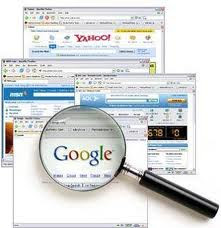The Internet, today, is a fun place for everyone. The newbie who is learning to use computers is no exception. Unfortunately, this was not the case back before 1989.
Back then, one had to be a professional, like a computer engineer, a software engineer... to be able to use the Internet. During then, one had to mingle with the back
Command-line interface to enter
source codes to issue instructions commanding the various
Internet Protocols to perform a task.
Proudly, this is not the case today as we all know. Thanks to the
WWW.
Story of the Internet
Part 1: A Fact that Provoked the Idea of the Internet.
Part 2: The First Computer Network to be Created.
Part 3: How the First Computer Network changed the World.
Part 4: The Creation of the Internet.
Part 5: The Origin of the World Wide Web (current post).
The
World Wide Web (WWW), in definition, is a system of internet servers that support hypertext to access several internet protocols (IPs) on a single interface. This definition takes us back to Tim Berner's Lee first creativity:
Hypertext. Hypertext
HypertextTim Berner's Lee is an English engineer and I'm glad to say that we have one thing in common - we both have computers in our blood.
In, 1980, Tim had a contract to work at
CERN for 6 months. This is where and when he created a program called 'Enquire Within'. Enquire Within was new and unique. It had electronic connections within a document and between different documents on different computers. It could organize information according to the content of document, not where they could be found, and... Enquire Within was Hypertext.
Hypertext is a special kind of text that is intended to give more freedom to the reader and the writer. It contains links that lead to other places: documents, text, pictures, programs, webpage, audio and video recordings. In simple terms, the power of hypertext is that it can lead to anything.
A New InventionNine years later, in 1989, Tim was back working again at
CERN. This time he felt that he ahd a new responsibility. But this was a responsibility that was not part of his day-to-day work schedule. It was a responsibility that was deeply motivated by who Tim is,
a man who just can't help but improve everything. In short, Tim wanted to improve communication between scientists and engineers at
CERN. He wanted to make communication easier and more efficient. So, one morning he approached the person in charge and explained his idea:
"
But Tim, that's computing, an area that does not concern us." The man incharge replied.
Tim tried harder to explain the benefits of his new idea but the final answer he received was not assuring:
"
Ok, I'll think about it."
Plan 'B'Mr. Lee saw that it wasn't going to be easy to get his way through and create a new program. But then he thought of this place where the computer men, engineers and scientists often meet during the breaks. He thought of the coffee room and he smiled at the wits of his second plan.
This was simply to face his colleagues and use them to pursue the creation of his new program. So he decided to meet the one by one:
"
Would you like to have links to all the information you need at work?" He would ask.
"
That would be great Tim, I have to travel all the way to CERN to get some information." Most of them answered.
Consequently, the pressure was not only coming from Tim, but all directions, and the ultimate response was the administration giving way.
 The New Program
The New ProgramImmediately, Tim started creating the new program and he called it the World Wide Web.
This program used a new invention, a system of addresses. In this system, anything, anywhere on the internet could have its own special address called
URL - Uniform Resource Locator.
Tim's browser program could allow writers to create links to anything they liked, and readers had the freedom to follow their interests from link to link. Tim also invented a set of rules for sending texts and pictures over the internet. The rules allowed documents to appear almost exactly the same, whatever the computer system was being used.
For web authors, Tim created a new scripting language called
HTML (Hypertext Markup language).
Over the years to today, the
WWW has constantly been in a continued development. It is improved everyday to cope up with the current trends in technology.
As you are reading this, Mr. Tim berner's Lee is the
President of the World Wide Web Consortium (
W3C).
"
We may find that the more we succeed in removing barriers to internet communications, the more we may help reduce those other, far more important obstructions to human communications - the ones that divide nations and estrange demographic groups."






















